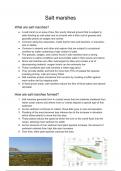Summary
Summary Salt Marshes - Coasts A-Level Geography CIE 9696
- Course
- Institution
This is a short summary of salt marshes, which is part of the CIE A-Level Geography syllabus (Coasts) The document explains what salt marshes are and how they are formed.
[Show more]



